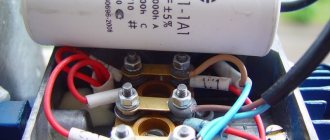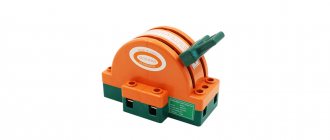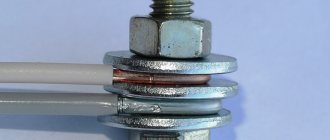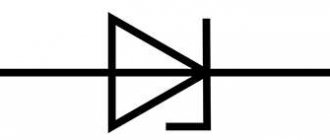What is a shunt? This word is borrowed from the English language (“shunt”, and literally means “branch”). Physically, this is comparable, since most of the current passes through this element, connected in parallel to the measuring device, and a smaller part is branched into the device itself. In this way, its operating principle is similar to the bypass installed in heating systems.
Ammeter device
To understand the need to turn on the ammeter through a shunt, let us briefly recall its structure.
Inside the field of a permanent magnet there is a coil - a frame. The measured current flows through its turns. Depending on the value of the measured parameter, the position of the coil relative to the constant magnetic field changes. The arrow of the device is rigidly fixed on its axis. The greater the current being measured, the more the needle deflects.
So that the frame can rotate, its axis is secured in the thrust bearings, or hung on guy wires. When using thrust bearings, the frame current passes through spiral springs, but if the moving part of the device is suspended on guy wires, then they are current conductors.
From this design it follows that the amount of current in the frame is structurally limited. Springs and extensions cannot simultaneously be sufficiently elastic and have a large cross-section.
Recalibration of the device
A new calibration of the updated dial ammeter for the new shunt must be done as follows.
- Remove the front part of the housing (the viewing window of the device) along with the glass.
- Connect one of the light bulbs of a known value in series with the ammeter to the battery or AC power adapter. Thus, incandescent light bulbs indicate the current in amperes and voltage in volts. If you connect an LED panel or headlight, which, for example, indicates a voltage of 12 V and a power of 24 W, your operating current will be 2 A (power divided by the voltage of the power source).
- Mark at what angle the arrow of the device has deviated with a dot with a number (in this case it is 2).
- The ideal option is to turn on identical light bulbs or headlights in parallel with each other, increasing their number by one each time. This way you can “mark” the entire ammeter scale. This method is good for alternating current - the ammeter scale is nonlinear due to the influence of the frequency of the current and the drop in part of the voltage across the diodes. Marking “by eye” or using a protractor (or using an existing “ruler” of the device), as is often done with direct current, will not work. It's better to play it safe and do it more accurately.
- Having completed the markings, assemble the device and check whether the shunt is securely fastened and whether the electrical contact between it and the ammeter is good. If the dimensions of the ammeter allow, the shunt is often filled with epoxy glue, and then the resulting element (in the form of a bar) is glued to the back wall of the measuring head.
The ammeter with the new shunt is ready for use. You can connect probes or current clamps.
Connecting an ammeter via a current transformer
Extending the measurement limits of the ammeter is possible if you use an additional device called a current transformer. It works on the principle of a conventional transformer, but the primary winding contains only a few turns. When the measured current passes through it, its value in the secondary winding will be several times less.
But such transformers have appropriate dimensions and are used only in industrial networks. In small-sized devices, their use is impractical.
Tags
last ammeter shunt meter ammeter and resistance ammeter.resistance ammeter.called ammeter. Measurements Measurements Large measurements Resistance measurements
valuecasemaximumbypassampmetersupplyscaleconnectedinparallelconnectedneedbyblockdiagramrangeserialresponseonedefineadditionalvariabledefinitionmultimeterconnectionshandfriendlinkinternalarrowmeasureaccuracymakeconductordivisionfurtherclasssourcesonlylengthwhichourdigitalcan
Connecting an ammeter via a shunt
If the device is connected directly to the measuring circuit, without a current transformer, it is called a direct-connection ammeter.
Without a shunt, you can use devices designed for low current, on the order of milliamps. By shunting the measuring winding with a resistance greater than its own, we can change the measurement limit. The connection circuit is no different in complexity: the measured current passes through the shunt, and an ammeter is connected in parallel to it.
This is where Kirchhoff's first law comes into play. The measured current is divided into two: one flows through the frame, the second through the shunt.
They will relate to each other like this:
What is needed?
To make a shunt, in addition to wire, wires, dielectric and fasteners, you will need the following devices.
- Ready milliammeter. You can also use a galvanometer - a measuring head without internal shunts, resistors, and so on.
- Laboratory power supply that produces the required amperage. You can also use a car battery, in a circuit with which, for example, a 100/90 W headlight based on an incandescent lamp is connected in series. If there is no such headlight, you can connect a piece of nichrome electric spiral or a powerful ceramic resistor with tens of watts. Do not under any circumstances connect the shunt to the device “short-circuited”, without load.
- When working with a household lighting network - a rectifying diode bridge (or single high-voltage diodes) and an additional 16 A circuit breaker, fuses for several amperes.
Voltage is supplied only after the circuit has been correctly assembled.
Shunt resistance calculation
It follows that, knowing the total deflection current of the measuring system (Ipr) and the internal resistance of the frame (Rpr), it is possible to calculate the required shunt resistance (Rsh). And thereby change the measurement limit of the ammeter.
But, before converting a milliammeter into an ammeter, you need to solve two difficult problems: find out the total deflection current of the measuring system and its resistance. You can find this data if you know the type of milliammeter that is being converted. If this is not possible, a series of measurements will have to be taken. Resistance can be measured with a multimeter. But for the second parameter, you will need to supply current to the device from an external source, measuring its value using a digital ammeter.
But such a calculation of a shunt for an ammeter will not be accurate. It is impossible to ensure the required measurement accuracy using available means. A measurement system with a shunt has greater sensitivity to errors in determining the initial data. Therefore, in practice, precise adjustment of the shunt resistance and calibration of the ammeter are carried out.
Adjustment of the measuring system
For the manufacture of factory products, materials are used that do not change their characteristics over a wide temperature range. Therefore, the best option is to select a ready-made shunt and adjust it for your purposes by reducing the cross-section and length of its conductor to match the calculated value. But to make a shunt for an ammeter, you can also use improvised materials: copper or steel wire, even paper clips will do.
Now you need a power supply with a voltage regulator to deliver the required current. For the load, you can use a resistor of appropriate power or incandescent lamps.
First, we achieve compliance with the total deflection of the instrument needle at the maximum value of the measured value. At this stage, we select the resistance of our homemade product to the maximum possible coincidence with the final mark on the scale.
Then we check whether the intermediate risks coincide with their corresponding values. If not, we disassemble the ammeter and redraw the scale.
And when everything worked out, we install the finished device in its place.
Read also: Causes of car compressor not working
Concepts and formulas
A shunt is a resistance that is connected parallel to the ammeter terminals (parallel to the internal resistance of the device) to increase the measurement range. The measured current I is divided between the measuring shunt (rsh, Ish) and the ammeter (ra, Ia) in inverse proportion to their resistances.
Shunt resistance rш=ra x Ia/(I-Ia).
To increase the measurement range by n times, the shunt must have a resistance rш=(n-1)/ra
1. An electromagnetic ammeter has an internal resistance ra = 10 Ohm, and the measurement range is up to 1 A. Calculate the shunt resistance rsh so that the ammeter can measure current up to 20 A (Fig. 1).
The measured current of 20 A will branch into a current Ia = 1 A, which will flow through the ammeter, and a current Ish, which will flow through the shunt:
Hence the current flowing through the shunt is Ish=I-Ia=20-1=19 A.
The measured current I=20 A should be divided in the ratio Ia:Ish=1:19.
It follows that the branch resistances must be inversely proportional to the currents: Ia:Ish=1/rа: 1/rsh;
Shunt resistance rш=10/19=0.526 Ohm.
The shunt resistance must be 19 times less than the resistance of the ammeter rа so that a current Ish passes through it, 19 times greater than the current Ia = 1 A that passes through the ammeter.
2. The magnetoelectric milliammeter has a measurement range without a shunt of 10 mA and an internal resistance of 100 ohms. What resistance should the shunt have if the device is to measure current up to 1 A (Fig. 2)?
When the needle is completely deflected, current Ia = 0.01 A will pass through the milliammeter coil, and through the shunt Ish:
from where Ish=I-Ia=1-0.99 A=990 mA.
The current of 1 A will be divided in inverse proportion to the resistances: Ia:Ish=rsh:ra.
From this relationship we find the shunt resistance:
10:990=rш:100; rsh=(10x100)/990=1000/990=1.010 Ohm.
When the needle is completely deflected, a current Ia=0.01 A will pass through the device, a current Ish=0.99 A will pass through the shunt, and a current I=1 A will pass through the common circuit.
When measuring current I = 0.5 A, current Ish = 0.492 A will pass through the shunt, and current Ia = 0.05 A will pass through the ammeter. The needle will deflect to half the scale.
At any current from 0 to 1 A (with the selected shunt), the currents in the branches will be divided in the ratio ra:rsh, i.e. 100:1.01.
3. The ammeter (Fig. 3) has an internal resistance ra=9.9 Ohm, and its shunt resistance is 0.1 Ohm. In what ratio will the measured current of 300 A be divided in the device and the shunt?
Let's solve the problem using Kirchhoff's first law: I=Ia+Ish.
In addition, Iа:Iш=rш:ra.
From the second equation we obtain the current Ia and substitute it into the first equation:
Current in the device Ia=I-Ish=300-297=3 A.
Of the total measured current, current Ia = 3 A will pass through the ammeter, and Ish = 297 A through the shunt.
Shunt for ammeter
4. An ammeter, the internal resistance of which is 1.98 Ohms, gives a full deflection of the needle at a current of 2 A. It is necessary to measure a current of up to 200 A. What resistance should the shunt connected in parallel to the terminals of the device have?
In this problem, the measurement range increases 100 times: n=200/2=100.
The required shunt resistance is rш=ra/(n-1).
In our case, the shunt resistance will be: rш=1.98/(100-1)=1.98/99=0.02 Ohm.
Shunting for hydrocephalus
Schematic representation of a typical shunt for hydrocephalus
Shunt surgery is the most common neurosurgical operation for hydrocephalus (water on the brain). It is performed to remove excess cerebrospinal fluid. After craniotomy, one end of the shunt, ending with a radiopaque catheter, is inserted into the cavity of the dilated ventricle. The intermediate, longest part, made of silicone, is carried out subcutaneously. The distal end, also containing a catheter, opens into the abdominal or thoracic cavity to allow drainage. Alternatively, a distal catheter is inserted into the right atrium (ventriculoatrial shunt). The shunt is equipped with a pump that automatically regulates the pressure of the cerebrospinal fluid.
Gastric bypass
Current and voltage measurement. voltmeter and ammeter
Gastric bypass is an operation aimed at combating excess weight. In North America (USA + Canada), according to information as of 2009, about 200,000 gastric bypass operations were performed per year.
The history of this operation goes back about 50 years.
The essence of the operation is that the stomach is stitched with staples into two sections - a small one, with a volume of about 50 ml, and a large stomach (the rest of the part.) The small intestine is sutured to the small stomach (the junction of the stomach and intestines is called gastroenteroanastomosis). Since the volume of the small stomach is only 50 ml, a person after this operation cannot eat a lot of food; he eats a very small amount.
In addition, food eaten by a person now takes a new route, avoiding the large stomach and most of the small intestine. This means that not only is the amount of food eaten reduced, but the absorption of nutrients is also significantly reduced.
Thus, the combination of these two factors - a decrease in the amount of food eaten and a decrease in the absorption of nutrients - leads to the patient losing up to 80% of excess weight.
This operation is currently considered as a two-stage operation, the first stage of which is gastroplasty or gastric banding, and if the primary operations did not lead to the expected result, then the second stage is the conversion of simpler operations into bypass surgery.
Vascular bypass surgery
Bypass surgery involves creating a shunt to bypass the narrowed section of the blood vessel, resulting in restoration of blood flow in the artery. Bypass surgery should be distinguished from stenting, i.e. implantation of a special tubular design into the lumen of the vessel, ensuring restoration of fluid flow.
In a normal case, the inner wall of arteries and vessels is a smooth surface without any large growths or obstructions, but often during a person’s life, atherosclerosis develops, leading to the formation of atherosclerotic plaques on the walls of blood vessels. They narrow the lumen of blood vessels and disrupt blood flow in organs and tissues. As the number and size of plaques increase, the lumen of the vessel completely closes, which leads to necrosis of tissues and organs.
Typically, bypass surgery is used for coronary heart disease, in which the coronary arteries - the main vessels that supply the heart - are affected by atherosclerosis. However, bypass surgery is also used to restore blood flow in peripheral arteries (for example, in the arteries of the lower limb).
Preparing for surgery
Before the operation, the attending physician conducts a full examination of the patient, taking into account his complaints and symptoms.
As a rule, after an examination, in which special attention is paid to the pulsation of arteries and vessels, some type of non-invasive (non-destructive) examination is prescribed:
- duplex ultrasound scanning;
- magnetic resonance angiography;
- X-ray contrast angiography.
Indications for surgery
The presence of symptoms of atherosclerosis (including coronary heart disease, aneurysms) is one of the grounds for prescribing bypass surgery, which is also prescribed if stenting and angioplasty are impossible.
Technique of the operation
Bypass surgery
As a rule, the operation is performed under general anesthesia. In general, a section of the saphenous vein of the thigh is chosen as a material for a shunt, since it has a fairly large cross-sectional diameter, and removal of its section has almost no effect on the blood flow of the limb. In addition, in the case of the development of atherosclerosis, the femoral veins are the most “clean” and not affected by the disease. However, sometimes synthetic materials are used to create a shunt.
In coronary artery bypass grafting, either the internal mammary artery or the radial artery of the arm is used. If the radial artery of the arm is selected, an additional examination is performed to determine the possibility of surgery and its effect on the blood flow of the arm. As a rule, the non-dominant hand acts as the donor (left for right-handed people and right for left-handed people).
During bypass surgery, the surgeon makes an incision within the intended location of the shunt on the vessel, after which the shunt is sutured to the incision, creating an additional path for blood flow. This is followed by examination procedures (ultrasound, angiography) to check the quality of the installed shunt and its proper functioning.
Postoperative period
The postoperative period lasts from 7 to 14 days (with normal healing of the postoperative wound). In the postoperative period, it is necessary to regularly bandage the wound. It is also advisable to prescribe antibiotics, non-steroidal anti-inflammatory drugs, analgesics and mandatory anticoagulants and antiplatelet agents. After discharge, the patient takes medications such as aspirin regularly and for life. Today, coronary bypass surgery, as the “gold standard,” is the most effective method of restoring blood flow in the coronary arteries of the heart.











